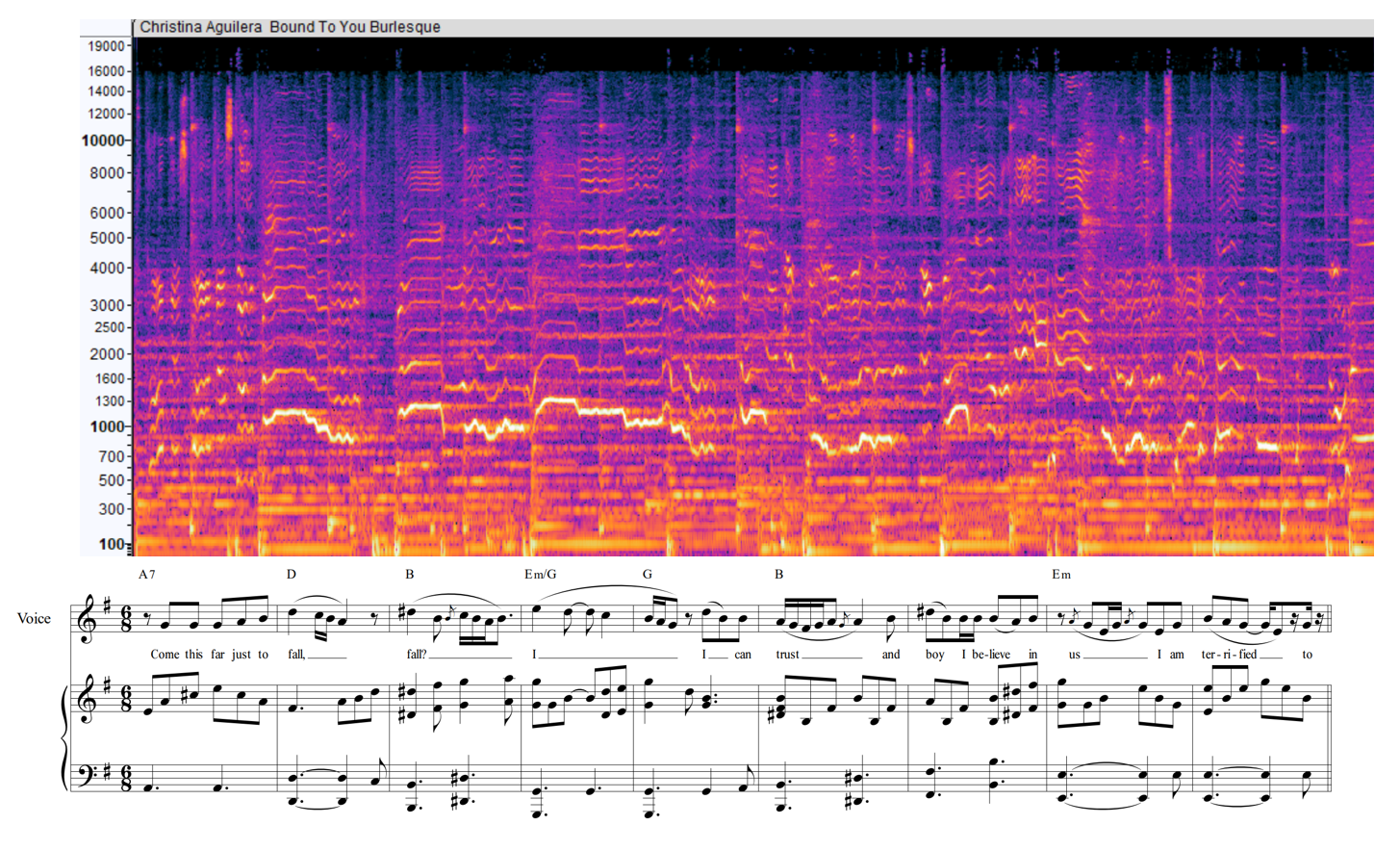Bound to You — Christina Aguilera
EN | FR
Bound to You — by Christina Aguilera
from Burlesque (2010)
Amazing Moments in Timbre | Timbre and Orchestration Writings
by Madison Stepherson
Published: March 3rd, 2022 | How to cite
In a moment of vocal, narrative, and timbral intensity, Christina Aguilera’s performance as the character Ali in the 2010 film Burlesque shatters the viewers’ expectations. Her voice, which had been alternating between a sweet, soft, intimate space in the verses of “Bound to You” and a resonant, confident, full voice in the chorus begins to build at the beginning of the bridge. Belting[1] out the notes, empathically the viewer can feel the tension building in her vocal tract. The longer she continues to belt, the more strain she puts on her vocal cords and the more difficult it becomes to remain in that register. A less talented singer might slip out of the belt and into mixed voice, but Aguilera continues on, driving to the climax of the song and a shining moment where timbre, melody, harmony, and narrative all come together in a resolution so satisfying that all one can do is bask in the sound. Finally, she begins to show some signs of vocal weariness — yet still rich and beautiful timbre — towards the end of the song, reminding us that she is human, too.
In this moment, protagonist Ali finally admits her love for Jack, the bartender. Cinematically, the first half of the song alternates between memories of their love story unfolding and shots of Ali on stage through the duration of the first verses and choruses. As the bridge approaches, though, the flashbacks cease, and the attention turns to a solo Ali on stage. The verses at the beginning of the song were relaxed, raspy, shaky, breathier, and darker, but the increase in tension as the chorus builds into the bridge (beginning at 2:45) also occurs with a distinct shift to belting which is carried higher and higher as her expressivity increases. To sustain a belt for extended periods of time is not only difficult for even expert singers, but it is also taxing on the vocal cords. Thus, to hear Aguilera continue to belt as she ascends to an E5 — a note that nears the high register of some singers but is only the middle of her impressive four octave vocal range that extends to C#7 — at the climax of both the song and phrase is not only amazing, but also near impossible for most singers to reproduce without cracking or introducing a significant amount of head or mixed voice (see figure 1 [2], showing the attached excerpt from 3:29-3:56).
Figure 1: Burlesque, from 3:29-3:56. To view the score and spectrogram separately, click here for the score and here for the spectrogram. Click here to download the XML file.
In this amazing moment in timbre, vocal virtuosity combines with harmonic and melodic resolution to signal the definitive narrative acceptance of Ali’s feelings towards Jack: The bridge begins with the lyrics, “Suddenly the moment’s here,” signaling that a moment of import, both musically and narratively, is coming. Her tone is bright, clear, and strong,[3] although still carries a bit of Aguilera’s signature raspiness. Increasing expressivity and tension on way to the arrival of the E5, she ascends chromatically through both D5 and D#5 on the repetition of the word “fall.” The lyrics leading here are “Do I risk it all? Come this far just to fall, fall?” It is as if Ali’s character is denying the option of falling by continuing the chromatic ascent upwards. The E5 arrival is elided with the arrival of the final chorus. The satisfaction stems from more than just harmonic arrival, though. The timbral effect of a talented singer belting out that E5 with clarity and confidence and continuing to belt even after the arrival completes it. The voice (and the listener mimetically as well)[4] feels as if it could explode if pushed any further, and yet, Aguilera continues. The raw emotion that Ali’s character feels is evident in Aguilera’s delivery and is heard and felt through — and therefore reliant upon — the timbre of her voice.
Work Cited
Feldman, Martha. 2015. The Castrato: Reflections on Natures and Kinds. Berkeley: University of California Press.
Heidemann, Kate. 2016. “A System for Describing Vocal Timbre in Popular Song.” Music Theory Online 22, no. 1. http://www.mtosmt.org/issues/mto.16.22.1/ mto.16.22.1.heidemann.html. Accessed Oct. 15, 2021.
Malawey, Victoria. 2020. A Blaze of Light in Every Word: Analyzing the Popular Singing Voice. New York: Oxford University Press.

